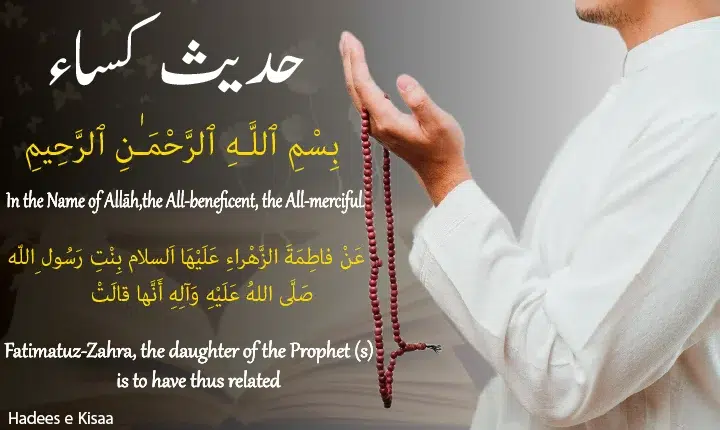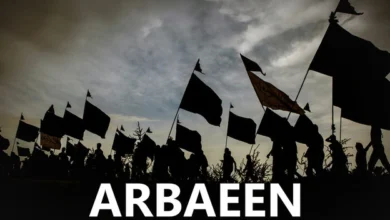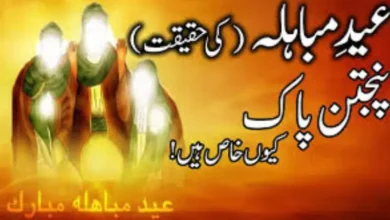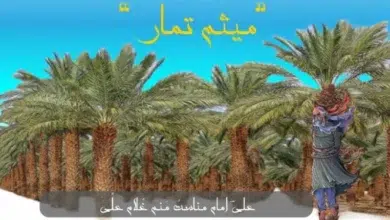
Hadees Kisa also known as the Hadees of the Cloak
The Hadees Kisa also known as the Hadees of the Cloak, is a prominent tradition that extols the virtues of the Prophet (s), Imam Ali (a), Hazrat Fatima (as) Imam Hasan (as) and Imam Hussain (as). The aforementioned event took place within the dwelling of Hazrat Umm e Salma, who was the wife of the Holy Prophet (pbuh). Holy Prophet Hazrat Muhammad (peace be upon him) enveloped himself, his daughter, his son-in-law, and his two grandsons with His Kisa (a type of cloak) and supplicated to Allah, saying:
“O Allah! These are my Ahl e bait and I pray for the purification of my Ahl e bait(family) by repelling all impurities and thoroughly purifying them. Subsequently, the Ayat e Tathir was reaveled.
The Ahl e bait(as) have cited the hadees as a virtue and a basis for their rightful claim to the caliphate of the Holy Prophet (pbuh).
The available pertaining to the event of kisa have not provided a comprehensive account, but rather have each presented a fragment of the incident. The subsequent account delineates the event utilizing the complete corpus of hadith literature pertaining to this matter.
The Prophet (peace be upon him) was situated within the abode of Hazrat Umm e Salma (as), the one of the wives of the Holy prophet (pbuh) .Holy Prophet asked Hazrat Fatima (may peace be upon her) for the Kisa as He was feeling sick and weak.
Hazrat Fatima as narrated that she was looking at the face of her father , it started glowing like the full moon. Holy Prophet (pbuh) instructed His daughter to retrieve her spouse and both sons, to which Hazrat Fatima (as) promptly complied and brought Ameer ul Momeneen Hazart Ali (as) Imam Hasan (as) and Imam Hussain (as) to the gathering.
The Holy Prophet Hazrat Muhammad (peace be upon him), his cousin and son-in-law Hazrat Ali (as) His daughter Hazrat Fatima (as) and His sons (accordinding to ayat e mubahila) Hazrat Imam Hasan (as) and Imam Hussain (as)gathered around and laid in the Kisa.
The Holy Prophet Hazrat Muhammad (peace be upon him) covered himself, along with his companions Ali, Fatima, al-Hasan, and al-Hussain, with his kisa or cloak. He then lifted the palm of his right hand towards the sky and uttered a supplication to Allah. The individual in question has expressed a desire for the purification of their Ahl e bait (family) through the repulsion of all impurities and a thorough purification process.
Subsequently,Hazrat Jabra’il (Gabriel) descended and disclosed the Tathir verse which reads as follows:
“Verily, Allah intends to keep away all impurities from solely the members of Ahl e bait (People of the Household) and purify them with a comprehensive purification. “The scriptural reference provided is Qur’an 33:33.
It is also stated that Hazrat Umm e Salma expressed her desire to seek shelter under the kisa’, however, the Prophet Muhammad (peace be upon him) intervened and prevented her from doing so. The individual inquired, “Am I not considered a member of the Ahl e bait?” According to the Prophet (pbuh), the individual in question is deemed to be on the path of righteousness and goodness, and is recognized as one of the wives of Allah’s prophet.
According to Allama al-Hilli, the Tathir Verse’s revelation at Hazrat Umm e Salma’s residence is a topic that has achieved consensus among the Islamic Umma. This is supported by narrations from the Imams (a) and numerous companions.
Undoubtedly, the house of Hazrat Umm e Salma is the location where the Tathir Verse was revealed and the event of Kisa took placed. According to Ibn Hajar, the aforementioned verse was revealed within the premises of Hzarat Umm e Salma’s residence. Upon being questioned about the Tathir Verse, ‘Umar deferred to ‘Aisha for clarification. ‘Aisha, in turn, directed the inquiry to Umm Salma, as the verse was revealed in her household and she possessed a greater understanding of its context. Suyuti cites Ibn Mardawayh’s account in al-Durr al-manshoor, wherein Umm Salma affirms that the verse of al-Tathir was revealed in her residence.
The authenticity of Hadees Kisa
The veracity of the aforementioned event is widely accepted and corroborated by esteemed Muhaddis who have documented it in their literary works. The Hadees in question exhibits Mustafid characteristics and upon further examination, it could potentially be classified as Mutawatir. The occurrence was of significant renown within the Islamic community, to the extent that the day on which it transpired came to be referred to as the day of Kisa. The five individuals who were the recipients of divine favor during the event were subsequently recognized as Ahl al-Kisa’ or Ashaab al Kisa (the people of Kisa’).
According to Al-Tabari’s work, Dala’il al-imama, there was a consensus among Muslims that during the revelation of the Tathir Verse, the Prophet (pbuh)summoned Hazrat Ali as Hazrat Fatima as Imam Hasan (as) and Imam Hussain (as) and enshrouded them with His kisa, subsequently praying:
“O Allah! These individuals are my family ,(Ahle bait) so please remove all impurities from them and purify them thoroughly.”
Hadees kisa Within the literature of the Shi’a tradition.
The narration of the Hadees kisa can be found in Shi’a exegetic literature such as Tafsir al-Qummi, Tafsir Furat al-Kufi, and Al-Burhan fi tafsir al-Quran.In Shi’a literature, the Hadees kisa is recounted in various Hadees books such as Usul al-Kafi and Amali
The Hadees Kisa is also presented in Sunni Hadees books. The aforementioned narration is documented in Sahih Muslim’s collection of hadees. According to Hazrat Aisha, the Prophet (pbuh) arrived on a certain day, donning a kisa made of black wool, which He carried on His shoulder.
Initially, Imam Hasan (as) arrived, and the Prophet (pbuh) proceeded to envelop Him with the kisa. Following this, Imam Hussain (as) arrived, and the Prophet (pbuh) proceeded to cover Him with the kisa’ as well.
Subsequently, Hazrat Fatima (as) arrived and proceeded to position Herself beneath the kisa, and finally,Hazrat Ali (as) arrived, and the Prophet (pbuh) enveloped him along with the others with the kisa. The Prophet (pbuh) then declared that Allah desires to eliminate all impurities solely from the Ahl e bait and purify them with a comprehensive purification.
According to Ibn Hajar’s account in al-Sawa’iq al-muhriqa, there exists an authentic chain of transmission which narrates that the Prophet (pbuh) utilised a kisa’ to cover the four and invoked Allah by saying: “O Allah!” The aforementioned individuals hold a significant place in my life as they are my Ahl e bait.
I implore that any impurities be removed from them and that they undergo a comprehensive purification process. [The hadees has been narrated by Ibn Athir in Usd al-ghaba, and Ahmad bin Hanbal in his Musnad. According to Ibn Taymiyya’s work, Minhaj al-sunna, the Hadees al-Kisa’ is considered to be an authentic Hadees. This particular Hadith has been narrated by al-Tirmidhi from Hazrat Umm e Salma the wife of Holy Prophet (pbuh), and by Muslim from Hazrat Aisha in his Sahih.
The narration of Hadees Kisa’ can be found in Sunni exegetic literature as well. This is evidenced by its inclusion in the works of al-Zamakhsahri’s al-Kashshaf, Fakhr al-Razi’s al-Tafsir al-kabir, al-Qurtubi’s writings, Ibn Kathir’s works, and al-Suyuti’s exegetic literature. In the exegesis of the Tathir Verse, Al-Qurtubi reports that Hazrat Umm e Salma narrated that upon the revelation of the Tathir verse, the Prophet (pbuh) summoned Hazrat Ali (as), Hazrat Fatima(as) Imam Hasan(as), and Imam Hussain as and covered them with a kisa.
The utilization of Hadees Kisa’ by Imams in their argumentation is a notable aspect in Quran
Imam Ali (as) cited the Hadees Kisa as a justification for his rightful claim to the caliphate of the Prophet (pbuh). He posed a question to Hazrat Abu Bakr, inquiring whether the Tathir verse was revealed in reference to Himself and His family or to Abu Bakr and his family.
The respondent provided an affirmative response, specifically pertaining to the individual and their familial relations. Imam Ali (as) made an oath by invoking the name of Allah and asked the following question. The supplication of the Prophet (pbuh) was directed towards my family and me, imploring Allah with the following words:
‘O Allah! The statement pertains to the Ahl e bait who are approaching the addressee, with the impliqurancation that they are not heading towards the fire.… Imam Ali (as) cited Ahl e bait as a justification for his precedence in governance and for his candidature for the caliphate of the Prophet (pbuh) during the assembly convened by ‘Umar bin al-Khattab to designate the succeeding caliph.
During a conversation among the companions of the Prophet (pbuh) regarding their respective virtues, Imam Ali (as) cited Hadees Kisa to assert the superiority of Himself and His family.
Following the conclusion of the peace agreement between Imam Hasan (as) and Mu’awiya, the latter delivered a speech. In response, Imam al-Hasan (as) referenced the Mubahala Verse and Hadees kisa as examples of the virtues of Ahl e bait (as) during his own speech.
Literature pertaining to the Hadees Kisa
Several scholars within the Shi’a tradition have authored literary works pertaining to the veracity of Hadees kisa including:
The Sanad-i Hadees kisa, which pertains to the narration of the Hadees kisa , was authenticated by Ayatollah Mar’ashi Najafi in the year 1356/1937.
The aforementioned text pertains to Ayat al-Tathir within the context of the five members of the household of the cloak, as authored by Muhyi al-Din al-Musawi al-Ghurayfi in the year 1377 of the Islamic calendar, corresponding to 1957-8 in the Gregorian calendar.
The Hadees kisa is a text that has been documented by Sayyid Murtaza Askari and has been published twice. The first publication was in 1395/1975-6, while the second publication included additional Shia sources and was released in 1402/1981-2. This text is recognised among the ahl al-Sunna community.
The works in question are Al-Tuhfa al-kisa’iyya by Shaykh Bafghi Yazdi (d. 1310/1892-3) and Kashf al-Ghita’ ‘an Hadith al-Kisa’ by Shaykh Ali Al Abd al-Ghaffar al-Kashmiri (d. 1345/1926-7).




